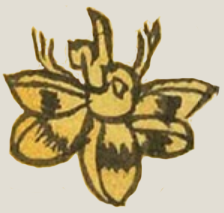xicotli (Mdz13r)
This element of a bee or wasp {xicotli) has been carved from the compound place name for Xicochimalco. The bee is painted in black and colored yellow. Some additional black coloring appears on the wings and back of the body, more reminiscent of a bumblebee than a honey bee or a wasp (which have more black stripes running horizontally across the body). The bee's head is pointing upward. The stinger, an eye, the double wings, and four of its six legs are included in this rather representative drawing.
Stephanie Wood
Bees held a place of importance in Aztec culture. Bees that were native to Mesoamerica were smaller than European bees and stingless; it is not clear which bee this glyph represents, but our online Nahuatl Dictionary suggests that the xicotli was a large bee. The Codex Mendoza also includes a place name, Pipiyoltepec, with a somewhat different depiction of a bee (see our attestations in this record). The Aztecs maintained hives of bees, consumed their honey, and had uses for the beeswax. (See: Eva Crane, The World History of Bee Keeping and Honey Hunting, 1999, 80.) The introduction of the Italian bee brought an increase in honey production, which may have impacted tributes. The Codex Mendoza includes an illustration of a tribute item, a "cantarillo de miel de abeja" (small container with bees' honey), showing a ceramic vessel, wrapped with possibly leather straps, with two handles on the sides, and a circular base upon which to sit.
Stephanie Wood
c. 1541, or by 1553 at the latest
Stephanie Wood
David Elliott made the SVG.
xicotl, bees, wasps, avispas, abejas, jicotes

xico(tli), bee/wasp, https://nahuatl.wired-humanities.org/content/xicotli
a bumblebee, or a large honey bee
la vispa, la abeja, el abejón, el abejorro
Stephanie Wood
Codex Mendoza folio 13 recto, https://digital.bodleian.ox.ac.uk/objects/2fea788e-2aa2-4f08-b6d9-648c00..., image 36 of 188.
The Bodleian Libraries, University of Oxford, hold the original manuscript, the MS. Arch. Selden. A. 1. This image is published here under the UK Creative Commons, “Attribution-NonCommercial-ShareAlike 3.0 License” (CC-BY-NC-SA 3.0).



